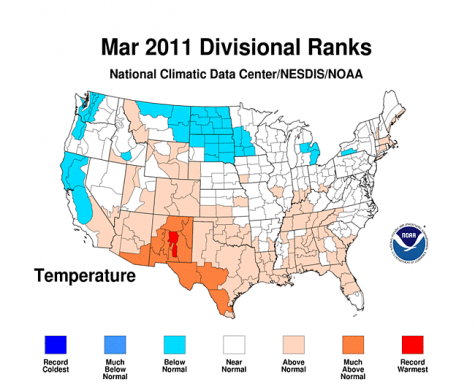March temperature "statewide ranks" maps are available at the NCDC site. Credit: NOAA
Last month, temperatures and precipitation in the contiguous United States averaged above normal, according to scientists at NOAA’s National Climatic Data Center in Asheville, N.C. The average temperature in March was 44.0 degrees F, which is 1.4 degrees F above the long-term (1901-2000) average. March precipitation, while record dry in areas like Texas, was overall 0.22 inch above the long-term average. The January – March temperatures were near-normal, while average precipitation was below-normal.
This monthly analysis, based on records dating back to 1895, is part of the suite of climate services NOAA provides.
U.S. climate highlights – March
Above-normal warmth dominated much of the southern U.S. and Rocky Mountains. The largest temperature departures were in Western Texas and New Mexico, which had its fifth-warmest March on record. Midland, Texas had four consecutive days—March 16 – 19—of temperatures that tied existing records.
Cooler-than-normal temperatures were present in the northern and western areas of the country. Conditions were especially cool from southwestern Minnesota across the Dakotas into eastern Montana. Within this belt, March temperatures were as much as 6 degrees below the 20th Century average.
Precipitation varied across the country, as the west and east coasts received above normal amounts, while the central and southern United States was largely dry. Texas had its driest March on record, with a statewide average of 0.27 inch. This was 1.47 inch below its 20th Century average, and broke the previous record of 0.28 inch set in 1971. It was the third driest March in New Mexico and 10th driest in Oklahoma.
Record warm maximum temperatures exceeded record cold minimum temperatures by a 5-to-1 ratio.
Washington, Oregon and California had their second, fifth, and ninth wettest March on record, respectively. Regionally, it was the second wettest March on record for the Northwest. In the Northeast, Pennsylvania had its third wettest such period.
Drought conditions continued to intensify across much of the nation in March. According to the U.S. Drought Monitor, the overall footprint of drought did not increase, holding fairly steady at about 24 percent of the country. However, the area covered by the “Severe” and “Intense” drought categories almost doubled, from about 12 percent early in the month, to more than 20 percent at month’s end.
Dry conditions across the Southern Plains contributed to above average wildfire activity during March. Across the U.S., approximately 385,000 acres burned, marking the second most active March in terms of wildfires on record, behind March 2006.
Tornado activity was above average, with 115 preliminary tornado reports. Most of the tornado activity was confined to the Southeast and Gulf Coast, which is typical of early spring.
Provided by NOAA




















